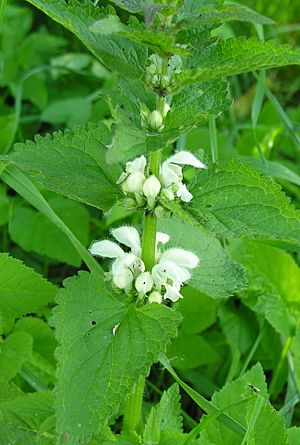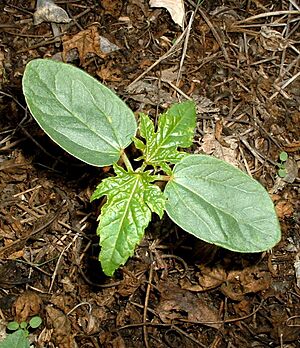Dicotyledon facts for kids
Quick facts for kids Dicotyledon |
|
|---|---|
 |
|
| Lamium album (white dead nettle) | |
| Scientific classification | |
| Kingdom: | |
| (unranked): | |
| Synonyms | |
|
Dicotyledoneae |
|

Dicots (short for dicotyledons) are a big group of flowering plants. Their name comes from a special feature: their seeds have two tiny first leaves. These leaves are called cotyledons. There are about 200,000 different kinds of dicots!
The other main group of flowering plants are called monocotyledons, or monocots. Monocots have only one cotyledon in their seeds. For a long time, scientists thought flowering plants were simply divided into these two main groups.
However, since the 1990s, scientists have used new ways to study plants. They look at the DNA of plants. This helped them learn that dicots are not one single, closely related group. Instead, they are many different plant families. Some of these families, like the magnoliids, split off from other plants very early on.
The largest group within the dicots is called the eudicots. These plants are very closely related. You can tell eudicots apart from other flowering plants by looking at their pollen. Eudicots have a special type of pollen. Other dicots and monocots have an older, simpler type of pollen.
How Dicots and Monocots Are Different
Besides the number of cotyledons, there are other ways to tell most monocots apart from dicots. These differences are mostly between monocots and the large group of eudicots. Some older dicot groups might have features that seem more like monocots. For example, some have vascular bundles (tubes that carry water and food) scattered in their stems. They might also have flowers with parts in groups of three. Also, some monocots can have leaf veins that look like a net, which is usually a dicot feature.
Here is a table showing the main differences:
| Feature | In Monocots | In Dicots |
|---|---|---|
| Number of flower parts | In groups of three | In groups of four or five |
| Number of pores in pollen | One | Three |
| Number of cotyledons (seed leaves) | One | Two |
| Vascular bundles in the stem | Scattered | In a circle |
| Roots | Grow from different places | Grow from the bottom of the seedling |
| Main leaf veins | Parallel (like stripes) | Net-like (like a net) |
| Secondary growth (stem gets thicker) | Usually not present | Often present |
Related pages
Images for kids
See also
 In Spanish: Dicotyledoneae para niños
In Spanish: Dicotyledoneae para niños


